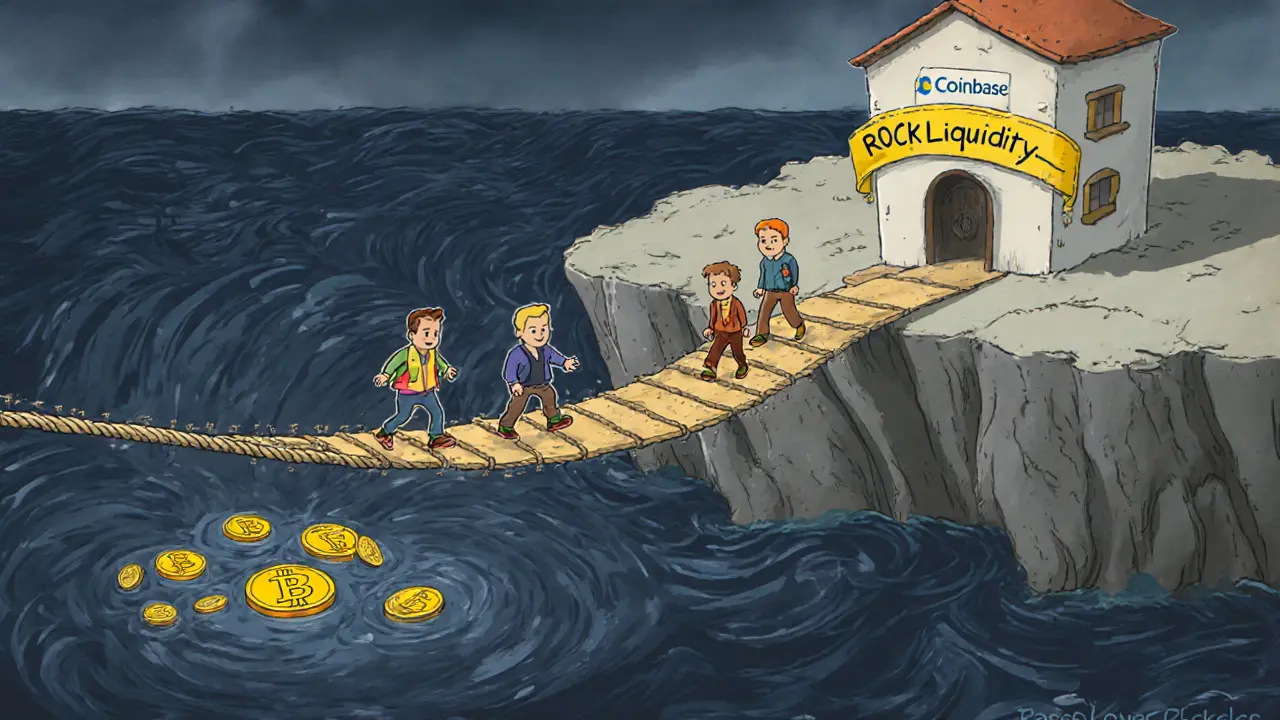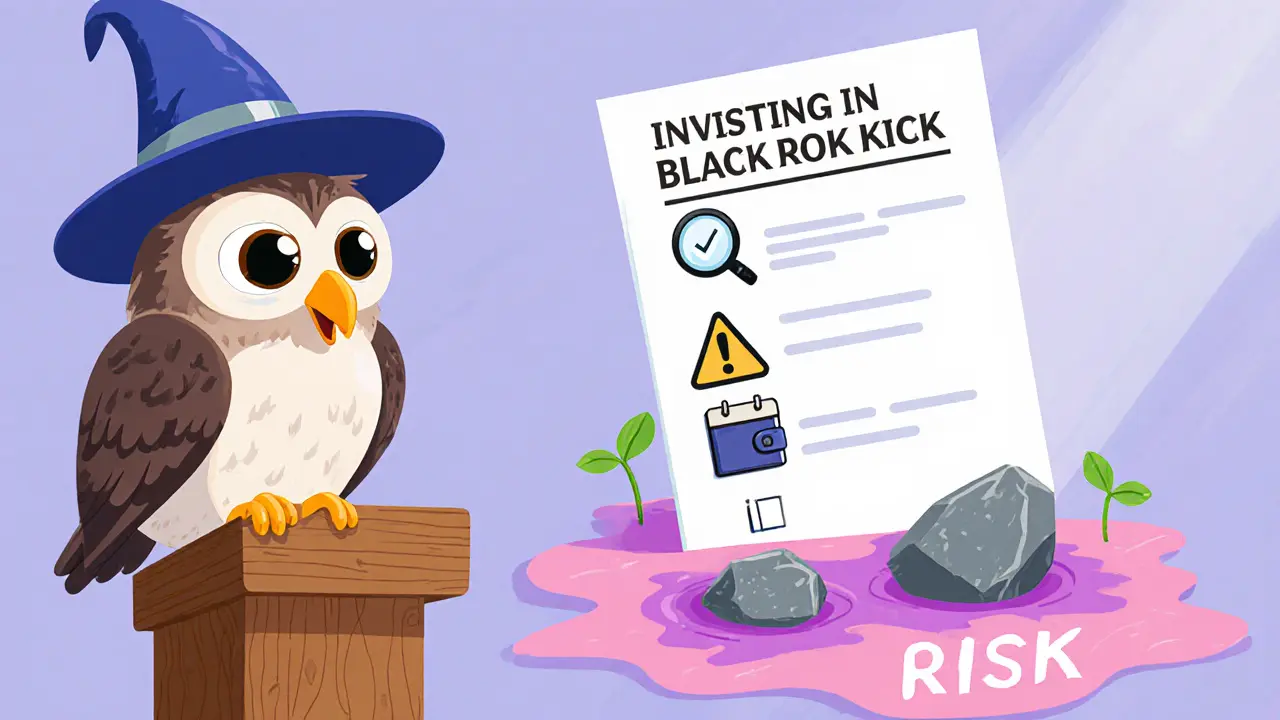BLACK ROCK (ROCK) Token Analysis Tool
Token Overview
Liquidity Risk Assessment
Zero trading volume indicates severe illiquidity. Large orders can significantly impact price.
Risk Factors
- Liquidity Risk High
- Information Vacuum High
- Utility Uncertainty High
- Price Volatility High
- Regulatory Exposure Medium
Comparison with Typical Microcap Token
| Metric | BLACK ROCK (ROCK) | Typical Microcap Token (ExampleCoin) |
|---|---|---|
| Launch Year | 2024 | 2023 |
| Blockchain | Base (Layer-2 on Ethereum) | Binance Smart Chain |
| Max Supply | 10 billion | 5 billion |
| Current Price (USD) | $0.000011 | $0.000045 |
| 24-hr Volume | $0 (zero) | $12,000 |
| Fully-diluted Market Cap | $113K | $225K |
| Known Use Case | None documented | Governance token for a DeFi protocol |
ROCK's liquidity and utility lag far behind even a generic microcap with an active DeFi use case.
Ever stumbled on a coin called BLACK ROCK crypto and wondered if it’s worth a glance? You’re not alone. The token popped up in 2024, rides on Coinbase’s Base layer‑2, and today sits at a price that barely registers on most charts. This guide breaks down exactly what the ROCK token is, how it works, and why you should treat it with caution.
What is the BLACK ROCK (ROCK) token?
BLACK ROCK is a cryptocurrency token launched in 2024 that operates on the Base blockchain platform. It carries the ticker ROCK and has a fixed maximum supply of 10billion tokens.
The token lives on Base, a Layer2 solution built on Ethereum the world’s leading smart‑contract platform. By leveraging Base, ROCK benefits from lower transaction fees and faster confirmations compared with the Ethereum mainnet.
Technical foundation: Base blockchain and Coinbase
Base is Coinbase’s answer to the high‑cost, congested Ethereum network. It inherits Ethereum’s security model while offering a cheaper, faster execution environment. Because Base is directly integrated with Coinbase’s exchange, users can move ROCK between their wallet and the exchange with a single click.
Coinbase also serves as the primary market where ROCK is listed. The exchange’s reputation lends a veneer of legitimacy, but the token’s activity tells a different story.
Tokenomics: supply, market cap, and price history
All 10billion ROCK tokens are already in circulation-there’s no reserve pool, no vesting schedule, and no burning mechanism. The fully‑diluted market capitalization sits at roughly $113K, calculated by multiplying the circulating supply by the current price of about $0.000011 USD.
ROCK hit its all‑time high on July72025, reaching $0.000038 per token. Since then, the price has slumped about 70%, landing near $0.000011 as of October82025. The decline happened over just three months, a red flag for any speculative asset.

Trading activity and liquidity concerns
Volume numbers are eye‑opening. Over the past 24hours, ROCK reported zero trade volume on CoinMarketCap. The 7‑day total volume is a mere $2.23, averaging $0.32 per day. Over 30days the total is $9.42, barely enough to cover a single small transaction.
Such thin liquidity means even modest orders can move the price dramatically, and large holders may find it impossible to exit without triggering a steep price drop. In practical terms, trying to sell a few hundred thousand ROCK tokens could wipe out most of the market value.
Distinguishing BLACK ROCK from BlackRockInc.
It’s easy to mix up the token with BlackRock Inc. the world’s largest asset‑management firm with over $10trillion in assets under management. The two have nothing in common beyond a similar name.
BlackRock Inc. is deeply involved in institutional crypto products-think the iShares Bitcoin Trust (IBIT) and a $1billion digital‑liquidity fund. Those initiatives target sophisticated investors and operate under strict regulatory oversight. ROCK, on the other hand, is a retail‑focused microcap token with virtually no institutional backing.
Risks and why caution is essential
- Liquidity risk: Near‑zero daily volume makes buying or selling difficult.
- Information vacuum: No clear whitepaper, roadmap, or verified developer team.
- Utility uncertainty: The token offers no known use case beyond speculative trading.
- Price volatility: A 70% drop in three months shows extreme price swings.
- Regulatory exposure: Microcap tokens are often scrutinized for securities violations.
If you’re drawn to the novelty of a new token, treat ROCK as you would any high‑risk penny stock: allocate only money you can afford to lose and keep expectations modest.

Quick comparison: ROCK vs. a typical microcap token
| Metric | BLACK ROCK (ROCK) | Typical Microcap Token (ExampleCoin) |
|---|---|---|
| Launch Year | 2024 | 2023 |
| Blockchain | Base (Layer2 on Ethereum) | Binance Smart Chain |
| Max Supply | 10billion | 5billion |
| Current Price (USD) | $0.000011 | $0.000045 |
| 24‑hr Volume | $0 (zero) | $12,000 |
| Fully‑diluted Market Cap | $113K | $225K |
| Known Use Case | None documented | Governance token for a DeFi protocol |
The table highlights that ROCK’s liquidity and utility lag far behind even a generic microcap that has an active DeFi use case.
Bottom‑line checklist for potential investors
- Verify the token’s contract address on a reputable explorer.
- Confirm any recent development updates-none are currently visible.
- Assess liquidity: can you exit without moving the price?
- Consider the broader market: most institutional money is still flowing into Bitcoin, Ethereum, and regulated products.
- Only allocate a tiny fraction of your portfolio, if at all.
Frequently Asked Questions
Is BLACK ROCK (ROCK) an official product of BlackRock Inc.?
No. The token is unrelated to BlackRock Inc., which focuses on institutional crypto products like iShares Bitcoin Trust. The similarity is only in name.
Where can I buy or sell ROCK?
ROCK is listed on Coinbase, but trading volume is effectively zero, making it hard to execute meaningful trades.
What is the purpose of the ROCK token?
Public information does not reveal any clear utility, roadmap, or community-driven use case. It appears to be a speculative asset.
How risky is investing in ROCK?
Extremely risky. The token has negligible liquidity, no documented development, and a 70% price drop in three months. Treat it as a high‑risk speculation.
Are there any upcoming developments or a roadmap?
No official roadmap or development updates have been published. The lack of a whitepaper or community channels suggests no near‑term plans.


Comments
Nicholas Kulick
The ROCK token’s liquidity is effectively zero, which means any sizable sell order will crush the price. With a max supply of 10 billion and no vesting, the market cap stays around $113 K, offering no buffer against volatility.
October 8, 2025 AT 09:14
EDWARD SAKTI PUTRA
I understand the lure of low‑price tokens, but the lack of trading activity on ROCK makes it feel like walking into a dead‑end alley; it’s hard to see a clear path forward.
October 8, 2025 AT 16:11
Bryan Alexander
Imagine stumbling upon a hidden gem that could skyrocket-yes, that’s the fantasy many have when they glance at ROCK’s price, but reality hits hard when the 24‑hour volume reads zero, turning hope into a mirage.
October 8, 2025 AT 23:08
Patrick Gullion
Sure, everyone paints ROCK as a dumpster fire, but sometimes the worst‑rated projects catch a surprise pump when a whale decides to flip the script.
October 9, 2025 AT 06:04
Jack Stiles
lol i saw this token and thought it was a joke, nvm it’s just another microcap that nobody’s buying, so dont expect any big moves.
October 9, 2025 AT 13:01
Ritu Srivastava
It’s morally reckless to hype a token like ROCK without any disclosed utility; pushing it as an investment is essentially gambling with strangers’ money.
October 9, 2025 AT 19:58
Liam Wells
Indeed, the ethical implications identified above demand rigorous scrutiny; nevertheless, one must also consider the market dynamics, which, despite the current illiquidity, could be susceptible to manipulation-an eventuality that should alarm both regulators and potential investors alike.
October 10, 2025 AT 02:54
Kate O'Brien
What if the zero volume isn’t just neglect but a deliberate throttling by exchanges to keep the token under the radar, allowing insiders to accumulate without public scrutiny?
October 10, 2025 AT 09:51
Ricky Xibey
Yo, even if you think it’s a hidden gem, you can’t sell it without tanking the price.
October 10, 2025 AT 16:48
Sal Sam
From a liquidity risk perspective, the order book depth is effectively nil, resulting in an infinite slippage scenario for any market‑order execution, which renders the token non‑viable for arbitrage strategies.
October 10, 2025 AT 23:44
Moses Yeo
One might argue that the very absence of volume is a testament to the market’s collective indifference, yet paradoxically, such indifference creates a vacuum ripe for speculative myth‑making-an ecosystem where belief outweighs data.
October 11, 2025 AT 06:41
Lara Decker
Calling ROCK a ‘potential opportunity’ is an exaggeration; the token lacks any substantive fundamentals and appears designed solely for speculative hype.
October 11, 2025 AT 13:38
Anna Engel
Oh sure, because the best investment advice always comes from assets with zero trading activity and no roadmap-what could possibly go wrong?
October 11, 2025 AT 20:34
manika nathaemploy
i feel u, the whole thing looks like a scam but sometimes ppl find hidden stuff in these low cap coins, just be very careful.
October 12, 2025 AT 03:31
Marcus Henderson
While the current metrics for ROCK appear daunting, a disciplined approach that emphasizes thorough due diligence and portfolio diversification may uncover niche use‑cases that could, over time, enhance its intrinsic value.
October 12, 2025 AT 10:28
Andrew Lin
This token is a total waste of american investors’ time-people should stick to real assets instead of chasing these foreign crypto scams!
October 12, 2025 AT 17:24
Caitlin Eliason
It’s a betrayal of every decent investor’s trust when projects like ROCK masquerade as legitimate-this is not just a bad investment, it’s a moral failure! 😡
October 13, 2025 AT 00:21
Ken Pritchard
For anyone feeling overwhelmed, start by verifying the contract address on a block explorer and checking if any reputable devs are interacting; this simple step can save a lot of headaches down the line.
October 13, 2025 AT 07:18
Brian Lisk
Investing in micro‑cap tokens such as ROCK requires a methodical framework that begins with understanding the token’s economic design. First, examine the supply mechanics; a fixed 10 billion token supply without vesting or burn schedules means the circulating amount is already at its maximum. Second, assess market depth; the reported 24‑hour volume of zero indicates that there is essentially no liquidity for buyers or sellers. Third, consider price history, noting the 70 % decline over three months, which signals extreme volatility and potential panic selling. Fourth, scrutinize the development activity by checking repositories, social media, and community channels for any sign of ongoing work. Fifth, evaluate the token’s utility, which in ROCK’s case is currently undefined, leaving investors without a functional reason to hold beyond speculation. Sixth, identify any regulatory red flags, as micro‑caps are often targeted for securities violations due to lack of transparency. Seventh, compare against similar assets; the table in the article shows that even a typical micro‑cap with a DeFi use‑case outperforms ROCK on every metric. Eighth, recognize the role of exchange listings; while ROCK appears on Coinbase, the absence of trading activity suggests the listing may be nominal. Ninth, calculate risk‑adjusted returns, acknowledging that the potential upside is limited by the market’s unwillingness to trade the token. Tenth, allocate only a minuscule portion of your portfolio to such speculative assets, treating them as a high‑risk gamble rather than a core holding. Eleventh, employ stop‑loss orders if your platform permits, to protect against sudden price drops that can wipe out your position. Twelfth, stay vigilant for any announcements or roadmap updates, which could either revive interest or confirm the token’s stagnation. Thirteenth, remember that liquidity constraints can turn even a small sell order into a massive price impact, effectively locking in losses. Fourteenth, diversify across multiple low‑cap tokens only if you have thoroughly vetted each one, to avoid a single point of failure. Finally, maintain a disciplined exit strategy, because waiting for a miracle pump in a token with zero volume is more akin to hoping for a unicorn than sound investing.
October 13, 2025 AT 14:14
Richard Bocchinfuso
Don’t expect any real gains from ROCK.
October 13, 2025 AT 21:11
Melanie LeBlanc
While the odds are stacked against ROCK, keeping a realistic perspective and limiting exposure can turn even a small loss into a valuable lesson for future portfolio decisions.
October 14, 2025 AT 04:08
Don Price
There’s a growing suspicion that the lack of activity surrounding ROCK isn’t merely accidental, but part of a coordinated effort by shadowy players to keep the token under the radar. These actors may be using the token as a testbed for market manipulation techniques that can later be deployed on larger, more visible assets. By maintaining virtually zero volume, they ensure that only a select few insiders can move the coin without attracting regulatory scrutiny. Such a strategy aligns with the broader narrative of hidden forces pulling strings behind the scenes of the crypto ecosystem. Moreover, the naming similarity to the world‑renowned BlackRock could be an intentional ploy to confuse casual observers and generate accidental hype. If regulators were to catch wind of this, they might issue warnings that would further suppress any genuine interest, preserving the status quo for those in the know. Investors should therefore treat any claim of imminent upside with extreme caution, recognizing the potential for deliberate misinformation. In essence, the token serves as a micro‑laboratory for covert financial engineering, and exposure to it may come at a hidden cost.
October 14, 2025 AT 11:04